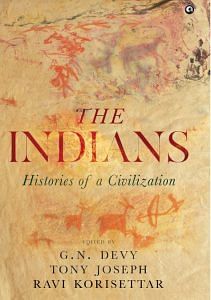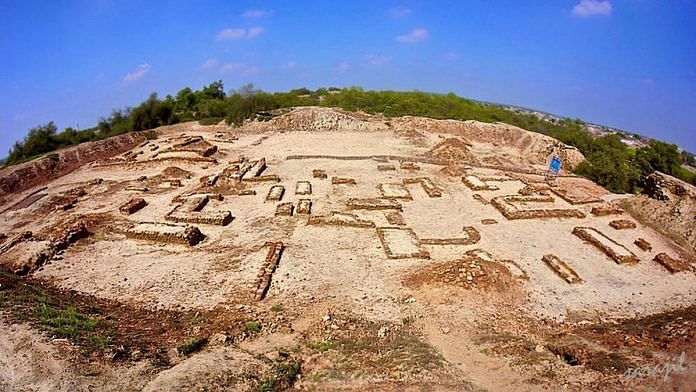The Ghaggar is important not only from the Vedic point of view but also from the Harappan. The Ghaggar was the lifeline of the Harappans. Of a sample of about 1,400 Harappan sites, more than 75 per cent are situated on the banks of the Ghaggar-Hakra channel. The older sites corresponding to the Early Harappan and Mature Harappan periods are located on the lower part of the Ghaggar-Hakra, whereas the Late Harappan sites are mainly found on the minor rivers in the Shivalik Hills. An in-depth study of the sites suggests that this upstream migration took place in c. 1700 BCE (Misra, 1994).
It is certain that the settlements on the lower course of the Ghaggar-Hakra River could not have been sustained at the present level of water supply. The river, therefore, must have been more watery in the past. The question is: how much more? The Harappan settlement pattern on the lower Ghaggar has been cited as a proof that the Yamuna and Satluj flowed into the Ghaggar (Misra, 1994). Such a conclusion is unwarranted. What the Harappans required from the Ghaggar was running water and not the combined might of two snow-fed rivers. Abundant rainfall, and/ or the overflow of the Satluj floodwaters into the old channels, would have probably met the requirements of the various Harappan-phase settlements on the Hakra. Alternatively, a small natural (or man-made?) duct transferring some water from the Satluj into the Hakra would have served the purpose. It is noteworthy that the Hakra settlements occupied slightly different geographical areas at different times, implying an erratic water supply (Mughal, 1992).
It is very likely that a mighty Ghaggar would have precluded the appearance of Chalcolithic settlements on its banks. Suppose for a moment that the Satluj and Yamuna were flowing into the Hakra in the Harappan times. When the two rivers changed course, we would have expected the Harappans to shift residence to the new banks of the two rivers. The Harappans did not do this but moved northwards to settle on the rainwater streams of the Shivaliks. It is noteworthy that the Harappans did not settle on the upper Indus and its eastern tributaries whose character as snow-fed rivers is similar to that of the Satluj or Yamuna (Misra, 1994). This suggests that the technologically-restricted Harappans had consciously avoided the snow-fed rivers and that the Hakra they knew was not a mighty river.
Also Read: Ali Shariati—the Paris-educated scholar who taught Iranian women how to be modern & Islamic
A study of the geological processes permits us to draw some conclusions about the life history of major rivers. During a glacial period, a large mass of water gets locked up in glaciers and ice caps, with the result that the sea level falls. It has been estimated that about 20,000 years ago, the sea level was about 100 metres lower than it is now. As the climate got warmer the snow melted, raising the sea level. About 6,000 years ago, the sea level stood 5–10 metres above the present level.
Since water is transported from the mountain top to the sea by rivers, climatic changes can be discerned in the rivers also. When the sea level is low, rivers cut deep valleys. And since there is much water to be brought down, rivers carry more water, making the deep valleys broad. Additionally, the river channels meander and the sand deposits are finer. As the sea level rises in the postglacial period, rivers have to learn to respond to the change. It follows from the laws of physics that the river valleys cannot be deeper than the sea level. Rivers, therefore, tend to fill their valleys with sediments; the process is known as aggregation. With a decrease in water supply, river channels become braided rather than meandering and sand deposits become coarser. Smaller rivers on their part may even fail to cope with the combination of diminished water supply and rising sea level, and simply dry up.
Detailed studies carried out in the Yamuna-Ganga (YaGa) Plain show that all the rivers are well entrenched in their valleys which they have been continuously filling up. It has been guesstimated that for the last 20,000 years, there has been no significant change in the course of the Ganga and by implication the Yamuna. In other words, if the Yamuna flowed into the Ghaggar, it must have been earlier than about 20,000 years ago (Singh et al., 1990).
A preliminary study of the Ghaggar’s hydrology was carried out during 1983-87 by an Indo-French team. An intricate analysis of solid samples and water-flow patterns suggested that the present water-deficient state of the Ghaggar has been in existence for ‘some tens of thousands of years’ (Courty, 1986). This conclusion has not found general acceptance, because it does not seem to be consistent with the observed high incidence of Harappan sites on the lower Ghaggar.
Also read: RSS praised Sanjay Gandhi. A Pune Marathi newspaper even brought out an edition for him
Climactic Changes
Recent studies have shown that the world’s climate has not remained the same but has undergone cyclic changes. The ancient climate of the Thar Desert has been reconstructed by analysing pollen scooped from different layers of sediment at the bottom of the saline lakes Sambhar, Lun-karan-sar and Didwana. Studies show that the rainfall was particularly heavy in the period c. 4000—3000 BCE. In about 2000 BCE or slightly later, there began a long drought lasting a few hundred years (Singhvi and Kar, 1992). There is similar evidence from the Western Ghats and the Nilgiri Hills, indicating that the aridity extended over the whole of India (Caratini et al., 1991). It has been suggested that similar conditions prevailed in central Asia also (Sarianidi, 1987) (Sukumar et al., 1993).
It is surmised that during this dry phase, the Ghaggar ceased to be a perennial river. Its bed was choked with sand, so that the lower part of the channel became incapacitated forever. The drying up of the lower Ghaggar would have compelled the settlers to move upstream. There are indications of water-induced migrations in south Turkmenistan as well.
In passing we may note that the Rig Vedic eyewitness account (RV 3.33) of Satluj’s being a part of the Indus system can be approximately dated with the help of Puranic genealogies. According to Yaska, Vishvamitra’s patron in this hymn was Sudas, who is placed three generations after Rama or at about 1400 BCE (Pargiter, 1913). At this time, the Satluj-less Ghaggar could not have been a mighty river. This is consistent with the archaeological evidence that the Hakra was waterless in ca. 1700 BCE. It is comforting to note that the much-maligned Puranas provide a date which is consistent with the archaeologically determined chronology.
The identification of the naditama Sarasvati with old Ghaggar was first proposed at a time when the Harappan civilization had not yet been discovered. However, if this identification is to be defended now, the archaeological evidence must be taken into account. From the Late-Harappan evidence it is clear that the Ghaggar could have been a mighty river only before 1700 BCE. If it was then the naditama Sarasvati, then all the settlements on its banks must have been Aryan settlements. In other words, if the Ghaggar is equated with the Rig Vedic Sarasvati, then the Harappans must be equated with the Rig Vedic people.
The corollary turns out to be more significant than the main theorem. If the Harappans and the Rig Vedic people are to be identified as one, then we must construct a cultural continuum that (i) extends from the Neolithic through the Chalcolithic to the Iron Age, and which (ii) not only accounts for the various phases of the Harappan tradition but also incorporates in it the Indo-European, Indo-Iranian and Indo-Aryan linguistic and mythological traditions. On the face of it, this does not seem to be a trivial task. Therefore, if the identification of naditama Sarasvati with the old Ghaggar is to be considered a plausible hypothesis, it must be presented not in isolation but in the context of the Harappan and Indo-Iranian traditions.
To sum up, the available literary and scientific data suggest the following hypotheses (Kochhar, 1999):
- The stage when the Satluj and Yamuna flowed into the Ghaggar was long over before the Harappan times.
- During the early and mature Harappan periods, the Ghaggar-Hakra channel was perhaps perennial or nearly so, to be able to sustain population groups on its lower course.
- In about 1700 BCE, the water supply diminished further, desiccating the lower part of the Ghaggar channel and forcing the later-period Harappans to migrate upstream to the Shivalik region.
- In about 1400 BCE there arrived, from the northwest, the Rig Vedic people who gave to the upper course of the Ghaggar the name (Vinashana) Sarasvati after the naditama Sarasvati (Helmand) they had left behind in Afghanistan.
The key to India’s prehistory lies in the hydrological history of the Ghaggar. Suppose it turns out that the Ghaggar was a powerful river in 2000 BCE. By itself this would not prove that the old Ghaggar was the Rig Vedic Sarasvati, because every mighty river need not be Sarasvati. But if it turns out (as is likely) that the Ghaggar has been more or less in its present state for say 10,000 years or more, then the Ghaggar would automatically be ruled out as a candidate for identification with the Rig Vedic Sarasvati.
 This excerpt from The Indians edited by G. N. Devy, Tony Joseph, and Ravi Korisettar has been published with permission from Aleph Book Company.
This excerpt from The Indians edited by G. N. Devy, Tony Joseph, and Ravi Korisettar has been published with permission from Aleph Book Company.



